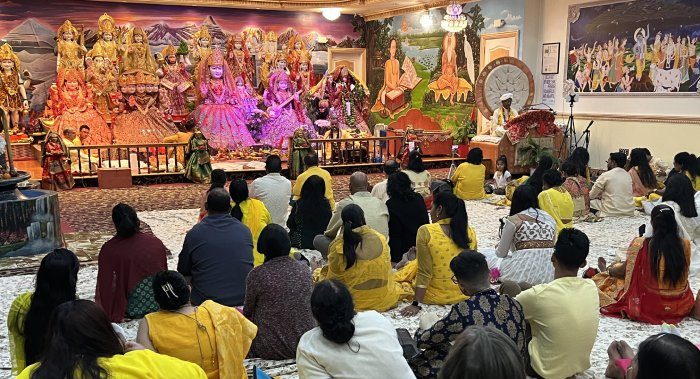The Hindu festival of Navratri, nine nights of worshipping the feminine aspects of God, Mother Durga and her reincarnations, Goddess Lakshmi and Saraswati, is being observed by the large Indian Guyanese and other Caribbean Hindu community in the greater New York area and other parts of the USA. The festival began on September 26 and concludes on Tuesday October 4.
Guyanese and other Caribbean Temples in America have been holding Ramayana sessions nightly during this period, and many Hindus have been conducting poojas or yajnas at their home. Temples throughout the New York metropolitan area have been packed with devotees throughout the observances including a nightly service presided over by Pandit Rajin Balgobin of New Amsterdam. The festival concludes with the celebration of defeat of Ravan (evil doings) also called victory or Vijay Dashmi.
Nav means nine and ratri means night. It is a festival that is celebrated during the night with prayers and spiritual dancing and a discourse about its meaning that also includes kirtan singing.
Navratri is the most auspicious period for Hindus during which time they fast and worship Goddess Durga and her reincarnations. Laxmi and Saraswati. Each Goddess is worshipped for three nights to offer protection (Durga), provide wealth (Lakshmi) and guide the devotee to knowledge (Saraswati) respectively.
During this time, worshippers tend to fast for the entire period, avoiding meat, sex, fish, eggs and maintain cleanliness in the homes for almost two weeks to maintain purity of mind and body to welcome the Lord in their home. As pandits explained, Goddess Durga is the collective manifestation of Brahma (creator), Vishnu (preserver), and Shiva (destroyer). As such when devotees worship Durga, they are worshipping the other manifestations of God as well. People worship for protection, love and comfort and Goddess Durga offers divine protection and removal of diseases.
During Navratri, devotees normally hold special prayers in the mornings and in the evenings to pay obeisance to the universal mother. They pray to the sun to burn the evil around society. It is the mother who provides her children with sustenance and as such she must be propitiated.
In the mornings, Guyanese Hindus offer jaal or dhar which is a mixture of curd, milk, honey, sugar, neem, cloves, hardi or ground dye, tills, and other sweet spices to appease the God to offer bliss over humanity. This tradition is a continuation of the prarticeinherited from Hindu ancestors going back to 1838 when they first arrived in then British Guiana as indentured laborers.
Guyanese Hindus continue the tradition of observing Navratri and other festivals in New York, New Jersey, Florida, Minnesota, Georgia, Texas and other places where they have settled. Other Caribbean Hindus joined Guyanese in observing the Navratri festival that commenced after the end of the two weeks festival of Pitri Paksh.
Guyanese and Trinis have helped to institutionalize Navratri and other Hindu as well as Islamic festivals in parts of America. They receive support and recognition from politicians. With regards to Navratri, the celebration included making offerings in the morning and evening over the nine days. The observance was extended into the Dussehra celebration on October 8; Dussehra means tenth day. Dussehra symbolizes the conquest of good over evil. All temples in the NY area held discourses on the occasion – some nightly discourses.
Navratri is one of the holiest periods in the Hindu calendar that was accompanied with people fasting, visiting mandirs, and performing pujas as well as inviting pandits to conduct special services at their home. People fasted during this period focusing on purification of the minds and bodies. During this period, people tend to pray with great fervour and devotion. Observants were seen nightly dressed in traditional colourful garb heading for the mandirs; there are dozens of mandirs in the greater Richmond Hill area. In New York, all of the temples held Navratri kathas and poojas. The pandits explained that Navratri is an extremely wonderful festival highly inspiring and instructive on how people should live.
Navratri which is directly linked to other Hindu festivals like Ram Leela, that will be celebrated right after Navratri which will be followed by Diwali and then karthik or Teerat that concludes the year for religious festivals. The famed Lord Rama is also associated with Navratri — his appearance, disappearance and reappearance in the holy city of Ayodha. In the spring Navratri, Hindus celebrate the birth of Lord Rama, and in the fall, Hindus celebrate the destruction of the evil Ravana by Lord Rama, signifying the triumph of good over evil which is also called Dussehra, a holiday in India. The Ramleela celebrations are associated with this period and some temples are holding such celebrations.
